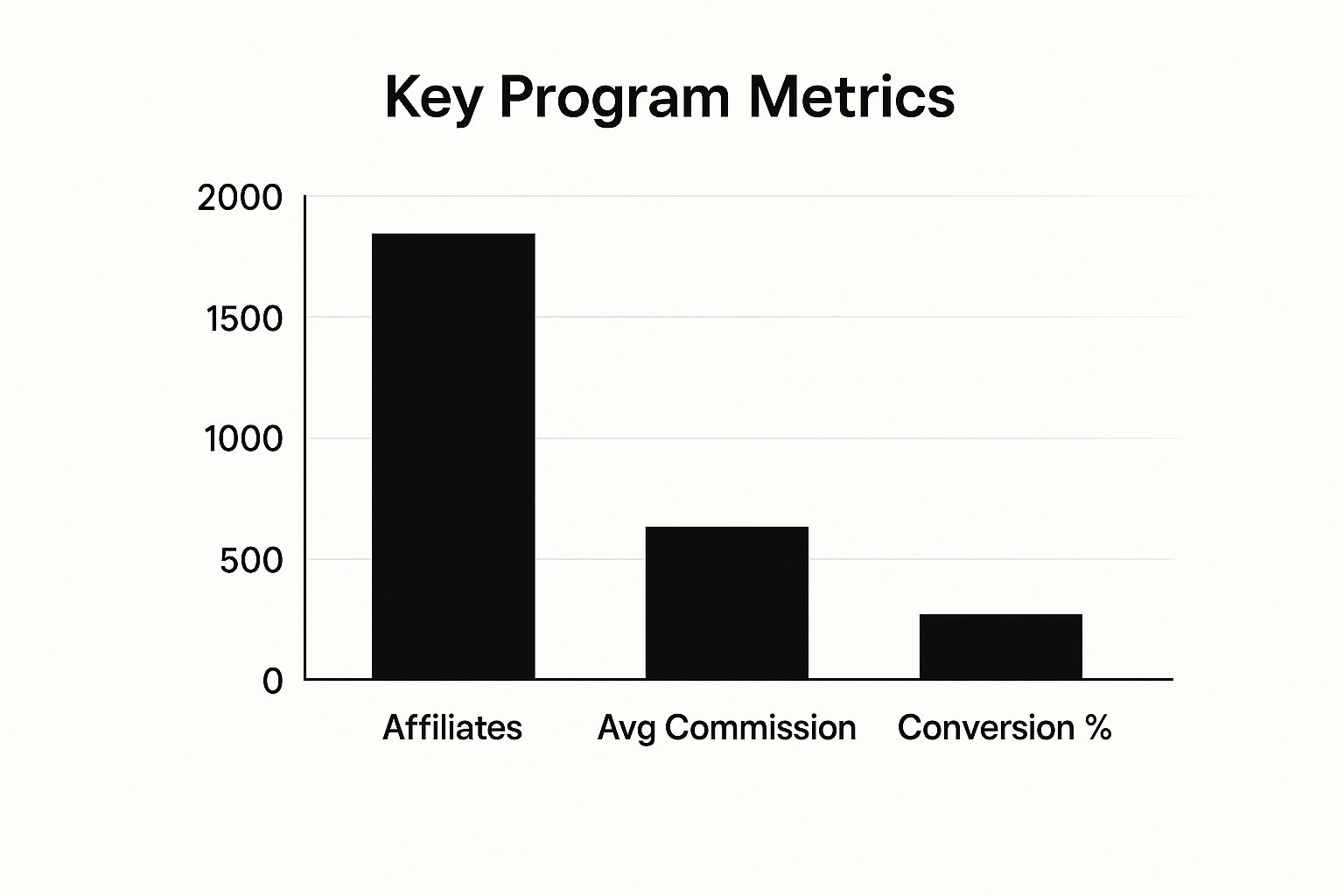The Evolving Landscape of Affiliate Marketing

The affiliate marketing ecosystem is constantly in flux. Strategies that yielded results just a few years ago might now be obsolete. This demands a proactive and adaptable approach to affiliate marketing program management. The old method of simply recruiting a large number of affiliates and hoping for the best is no longer effective.
Instead, successful programs prioritize quality partnerships over quantity. This necessitates a more strategic approach to program management, focusing on cultivating genuine collaborations.
Understanding the Modern Consumer
A key aspect of this evolution is understanding the changing consumer landscape. Today's consumers are more discerning and less receptive to generic advertising. They are increasingly influenced by authentic recommendations from trusted sources.
This means affiliate programs must prioritize partnerships with influencers and content creators who genuinely connect with their target audience. The focus is shifting beyond simple click-based metrics towards engagement, brand alignment, and long-term value.
The Rise of New Technologies
The rise of new technologies and platforms, such as AI-driven tools, is reshaping affiliate marketing. Artificial Intelligence (AI) offers opportunities for automation and personalization within affiliate programs. However, it also introduces new challenges related to data privacy and compliance.
Savvy program managers are strategically embracing these technologies to enhance efficiency and effectiveness while mitigating potential risks. This includes implementing robust tracking and reporting systems to accurately measure program performance and pinpoint areas for improvement.
Industry Growth and Competition
The global affiliate marketing industry has experienced significant growth, reaching an estimated $8.2 billion in 2022. Projections indicate it will surpass $31 billion by 2031. This expansion is driven by factors like the growth of e-commerce and the integration of AI innovations within affiliate programs. For a deeper dive into these statistics, explore this resource: Learn more about affiliate marketing growth statistics.
As the industry expands, competition for high-performing affiliates intensifies. Effective affiliate marketing program management requires a keen understanding of this competitive landscape. Developing a compelling value proposition for potential partners is crucial.
This could involve offering competitive commission rates, providing exclusive resources and support, and fostering a strong sense of community among affiliates. Ultimately, successful programs view their affiliates as valuable extensions of their brand. They invest in building long-term relationships based on trust, transparency, and mutual benefit.
Crafting a Program Structure That Actually Works
Building a successful affiliate marketing program requires a structured, strategic approach. It's not about simply scattering links and hoping for the best. Instead, much like constructing a building, it involves careful planning of the program's architecture, terms, and incentives to ensure it can scale and thrive. This also means recognizing why some programs fail while others flourish.
Architecting Your Program for Scalability
Many affiliate programs struggle due to a weak foundation. Overly complex requirements or insufficient support can overwhelm affiliates, leading to frustration and ultimately, poor performance. A well-structured program, however, empowers affiliates to succeed. This involves providing clear guidelines, accessible resources, and a streamlined communication process. Think of it as providing a comprehensive toolkit to your partners; the better the tools, the more effective their work.
Designing Terms That Attract and Protect
Effective program terms require a balance between the needs of your business and your affiliates. Competitive commission rates and reasonable cookie durations are crucial for attracting high-quality partners. Equally important is protecting your brand by establishing clear guidelines regarding promotional strategies and brand representation. Prohibiting spam tactics or misleading claims, for example, safeguards your reputation and cultivates a healthy partner ecosystem.
Commission Models That Incentivize the Right Behaviors
The commission structure is the heart of your affiliate program. A poorly designed model can lead to partner cannibalization, where affiliates compete for the same conversions, hindering overall growth. A well-crafted structure, on the other hand, rewards desired behaviors like focusing on high-value customers or promoting specific product lines. This strategic approach to affiliate marketing program management can significantly impact program performance. Consider tiered commissions, where higher sales volumes unlock higher rates, encouraging consistent effort and growth.

The infographic above visualizes key program metrics, such as the number of active affiliates, their average monthly commission, and the overall conversion rate. The data highlights that a smaller group of highly engaged affiliates generating higher average commissions can often outperform a larger, less active group. This underscores the importance of prioritizing quality over quantity in affiliate marketing program management.
Understanding the demographic landscape of affiliate marketing is also key. While 54% of affiliate marketers are male, over 75% of affiliate marketing managers are female. High commission rates, particularly in the SaaS sector (ranging from 20% to 70%), combined with the increasing prevalence of AI, make the field highly attractive. More detailed statistics are available here. These factors contribute to a significant ROI, with 65% of retailers reporting a revenue increase of 20% or more through affiliate channels.
To build a successful program, understand these dynamics and structure your program accordingly. This allows you to strategically recruit, train, and manage affiliates for optimal performance.
To help program managers benchmark their commission offerings, let's look at a comparison across different industries.
The table below, "Commission Structure Comparison by Industry," presents a comparison of typical commission rates, models, cookie durations, and average earnings per click (EPC). This data provides a valuable benchmark for evaluating and optimizing your program's commission structure.
| Industry | Average Commission Rate | Commission Model | Cookie Duration | Average EPC |
|---|---|---|---|---|
| Fashion | 5-15% | Revenue Sharing | 30-90 Days | $0.50-$1.50 |
| Beauty | 3-10% | Revenue Sharing, Cost Per Acquisition (CPA) | 30-60 Days | $0.30-$1.00 |
| Software/SaaS | 20-70% | Revenue Sharing, Recurring | 30-90 Days | $1.00-$5.00 |
| Finance | $50-$500+ | CPA, Cost Per Lead (CPL) | Varies | $2.00-$10.00+ |
| Travel | 2-8% | Revenue Sharing | 7-30 Days | $0.20-$0.80 |
As you can see, commission structures vary significantly across industries. SaaS businesses tend to offer higher rates due to higher customer lifetime value, while industries like finance often utilize CPA or CPL models. Cookie durations also vary depending on typical buying cycles within each sector.
By analyzing this data and comparing it to your own program's performance, you can identify areas for improvement and optimize your commission structure to attract and retain high-performing affiliates. This proactive approach to program management is essential for maximizing your ROI and driving sustainable growth.
Finding and Activating Partners Who Actually Perform

Let's be honest: most affiliates in any given program rarely generate significant revenue. This requires a shift in how we think about affiliate marketing program management. Instead of focusing on the quantity of partners, we need to prioritize quality. This section explores how successful programs find and activate the right partners—the ones who truly drive results. For further reading, check out this article on how to master getting affiliates.
Moving Beyond Traditional Recruitment
Traditional recruitment methods often miss the mark. By casting a wide net, they attract numerous affiliates, but many lack real influence or alignment with your target audience. For example, relying solely on affiliate networks can lead to a roster of inactive partners who joined multiple programs without a genuine interest in your specific brand. This creates a large but ultimately underperforming affiliate base. Instead, concentrate on targeted recruitment strategies.
Targeting Influencers and Content Creators
One effective strategy is identifying influencers and content creators who already connect with your ideal customer. These individuals have an established audience and credibility within your niche. This means their recommendations hold more sway than generic banner ads. Look for partners who genuinely appreciate your product or service. Their authentic enthusiasm will result in more compelling promotions and stronger audience engagement.
Evaluating Partner Potential Beyond Surface Metrics
When you’re evaluating potential partners, don't just look at follower counts or website traffic. These surface-level metrics don't always indicate actual influence. Dig deeper and assess their engagement rates, audience demographics, and the overall quality of their content. Look at how their audience interacts with their posts—likes, comments, and shares. Also, consider how their values and brand image align with yours. A strong fit will ensure a more genuine and productive partnership.
Crafting Personalized Outreach and Onboarding
Personalized outreach is essential for attracting high-quality affiliates. Generic, mass emails frequently end up in spam folders. A customized message showing genuine interest in a potential partner's work is much more likely to get a response. Mention specific content they've created or highlight how their audience aligns with your target market. After an affiliate joins your program, a well-structured onboarding process is vital for quicker time-to-revenue.
Accelerating Time-to-Revenue Through Effective Onboarding
Effective onboarding involves providing clear guidelines, easy-to-access resources, and dedicated support. This ensures affiliates understand your program's terms and conditions, have the tools they need for success, and feel valued. Offering personalized training, assigning dedicated account managers, and providing readily available marketing materials can dramatically improve affiliate engagement and performance. By investing in these key steps, you can help transform passive partners into active revenue generators. This focused approach to affiliate marketing program management builds strong, mutually beneficial relationships, contributing to long-term program success.
Turning Passive Partners Into Consistent Revenue Drivers
A successful affiliate marketing program thrives on more than just initial recruitment. It's about cultivating long-term engagement and transforming passive partners into active contributors to your revenue stream. This requires a shift from simply onboarding affiliates to actively managing and nurturing their involvement. Proactive affiliate marketing program management, with a focus on ongoing optimization and individualized support, is key.
Segmenting Your Partner Base for Targeted Engagement
Effective partner activation often begins with identifying and collaborating with niche influencers, sometimes called microinfluencers. Recognizing that each partner has unique strengths and needs is fundamental to effective affiliate marketing program management. Segmenting your affiliate base allows you to customize your communication and support based on individual partner performance and preferences.
Consider segmenting partners based on their promotional strategies (e.g., social media, email marketing, content marketing), their performance levels (e.g., top performers, mid-tier, inactive), or the specific industry niches they operate in. This targeted approach ensures your efforts are concentrated where they'll yield the best results.
Identifying Opportunities for Optimization
Consistent monitoring and analysis of key metrics are essential for identifying areas for optimization. Track clicks, conversions, and average order value to gain insights into partner performance. By analyzing this data, you can pinpoint struggling partners and offer tailored support.
This support might include additional training resources, access to exclusive promotional materials, or personalized feedback on their current marketing strategies. Regular communication with your partners is also crucial. It allows you to gather valuable feedback and identify areas for program improvement. This collaborative approach can reveal hidden opportunities to boost partner engagement and elevate overall program performance.
Implementing Tiered Support Systems
As your affiliate program expands, structured support systems become vital. A tiered approach allows you to efficiently provide personalized assistance. Consider creating a self-serve knowledge base with FAQs and tutorials for addressing common inquiries. Articles like How to master affiliate marketing program management can be valuable resources.
For high-performing partners, dedicated account managers can provide personalized guidance and support, enabling them to maximize their success. This tiered approach ensures all partners receive appropriate support while optimizing resource allocation for maximum impact.
Reviving Inactive Partners
Inactive affiliates represent untapped potential. Re-engaging these partners often requires a personalized touch. Consider sending a personalized email highlighting new product launches, offering exclusive bonuses or incentives, or simply checking in to understand any challenges they're facing. Sometimes, a simple gesture of outreach can rekindle their interest and motivate them to reactivate their promotional efforts.
To provide a more detailed look at effective engagement tactics, the following table summarizes various strategies and their impact on affiliate performance:
A table summarizing different affiliate engagement tactics and their impact on key performance metrics is presented below. This information can be invaluable in helping you refine your approach and maximize the effectiveness of your engagement strategies.
| Engagement Tactic | Implementation Effort | Average Response Rate | Impact on Conversion | Best For |
|---|---|---|---|---|
| Personalized Emails | Low | Moderate | High | Re-engaging inactive affiliates, nurturing relationships |
| Exclusive Bonuses/Incentives | Medium | High | High | Motivating top performers, driving short-term sales |
| Dedicated Account Manager | High | Very High | High | Supporting top performers, maximizing long-term growth |
| Training Webinars | Medium | Moderate | Medium | Upskilling all affiliates, improving overall program performance |
| Regular Performance Reports | Low | Low | Medium | Monitoring progress, identifying areas for improvement |
By implementing these strategies and continually refining your approach, you can transform passive affiliates into consistent revenue drivers, maximizing the return on investment of your affiliate marketing program and driving sustainable growth for your business.
Beyond Clicks and Conversions: Measuring What Actually Matters

Many affiliate marketing programs focus heavily on clicks and conversions, often viewing them as the primary indicators of success. However, these surface-level vanity metrics can be deceptive. They may present a facade of growth while obscuring underlying problems within the program. This section explores how to identify and measure the metrics that truly drive success in affiliate marketing program management. Want to learn more about the nuances of affiliate programs? Check out this helpful article on the differences between affiliate marketing and referral marketing.
Moving Beyond Vanity Metrics
While clicks and conversions hold some importance, they don't paint the whole picture. For example, a high click-through rate without a corresponding rise in sales might indicate issues with the landing page experience or the product itself. Similarly, focusing solely on conversions can lead to neglecting other vital aspects, such as customer lifetime value or average order value. It requires a shift in perspective towards metrics that offer a more comprehensive understanding of program performance.
Identifying Key Performance Indicators (KPIs)
Pinpointing the right Key Performance Indicators (KPIs) is the first step towards effective measurement. These KPIs should directly align with your overarching business objectives and provide actionable insights. Some crucial KPIs to consider include:
Customer Lifetime Value (CLV): CLV measures the total revenue generated by a customer throughout their relationship with your business. A higher CLV signifies stronger customer loyalty and increased long-term profitability.
Average Order Value (AOV): AOV represents the average amount spent per order. Boosting AOV can significantly increase revenue without acquiring additional customers.
Affiliate Partner Engagement: This KPI gauges how actively your partners are promoting your offerings. Tracking metrics like email open rates, click-through rates on affiliate links, and social media engagement can uncover valuable performance data.
Return on Investment (ROI): ROI measures the profitability of your affiliate program by comparing the revenue generated against the program costs.
Building Reporting Systems for Actionable Insights
Effectively tracking these KPIs requires robust reporting systems. These systems should offer real-time data and facilitate granular analysis. For instance, segmenting data by affiliate partner, product, or campaign allows you to identify top performers, pinpoint areas needing improvement, and make informed, data-driven decisions. This information can then be used to optimize your program and maximize ROI.
Developing Accurate Attribution Models
Understanding which marketing channels are driving conversions is essential. This is where attribution models play a vital role. A well-structured attribution model accurately assigns credit to each touchpoint in the customer journey. This provides a clearer view of affiliate partner contributions and enables more effective resource allocation. For example, a multi-touch attribution model acknowledges the influence of various marketing channels, including affiliate marketing, social media marketing, and email marketing.
Using Data to Drive Strategic Decisions
Ultimately, data should inform strategic decision-making. By analyzing program performance, you can identify opportunities to refine your commission structure, personalize partner support, and improve your overall affiliate strategy. This data-driven approach allows you to build a more effective and sustainable affiliate program. This proactive approach to affiliate marketing program management translates data into actionable strategies, fostering long-term growth and profitability.
Protecting Your Program From Compliance Issues and Fraud
The affiliate marketing landscape presents unique challenges. Compliance and fraud are two key areas requiring proactive affiliate marketing program management. Understanding potential pitfalls is crucial. Ignoring these risks can severely damage your brand's reputation and impact your profits.
Navigating the Regulatory Landscape
Compliance issues can quickly derail affiliate programs. Different regions have unique regulations. These govern advertising disclosures, data privacy, and payment processing. For instance, the General Data Protection Regulation (GDPR) in Europe imposes strict rules on data handling. Similarly, the US Federal Trade Commission (FTC) mandates clear disclosures in affiliate marketing materials. Staying informed and ensuring adherence to these regulations is vital. This protects your business from penalties and maintains legal compliance.
Developing Protective Program Terms and Conditions
Your program's terms and conditions are your first line of defense. These documents outline acceptable practices. They cover promotional activities, disclosures, and consequences for violations. For example, prohibiting spam, misleading claims, and unauthorized promotions mitigates risk. Including data privacy and intellectual property protection safeguards your brand. This ensures partners operate within legal boundaries.
Implementing Robust Monitoring Systems
Vigilance is key to identifying and addressing fraud. Implement monitoring systems to track key metrics. These include clicks, conversions, and affiliate activity. Tracking your campaign performance metrics is essential. Watch for unusual patterns. Sudden spikes in clicks or conversions from suspicious IP addresses are red flags. These could indicate click fraud or cookie stuffing. Early detection allows for swift action. This protects program integrity and prevents further exploitation.
Creating Efficient Review Processes
Effective review processes ensure compliance. They also prevent operational bottlenecks. Regularly review affiliate websites and materials. Check marketing practices for potential violations. This includes reviewing product claims, disclosures, and promotional methods. Manual reviews provide vital oversight. They also maintain quality control. Consider automated tools. These can streamline the review process and identify potential issues.
Recognizing Common Fraud Patterns
Understanding common fraud schemes protects your program. Some prevalent tactics include:
Click Fraud: Artificially inflating click counts to generate unearned commissions.
Cookie Stuffing: Embedding affiliate cookies without user consent, hijacking conversions.
Fake Leads: Submitting false lead information, often through bots or fabricated profiles.
By understanding these tactics and taking proactive measures, you build a resilient program. This safeguards your brand and maximizes ROI. These strategies contribute to long-term success. They foster a trusted environment for your business and affiliate partners.
Positioning Your Program For Long-Term Success
The affiliate marketing landscape is constantly changing. Successful programs are those that adapt proactively, anticipating trends and embracing innovation. This requires forward-thinking affiliate marketing program management.
Integrating Affiliate Strategies With Broader Marketing Initiatives
Effective program managers are moving beyond isolated approaches, integrating affiliate strategies with broader marketing initiatives. This creates synergy, where affiliate marketing amplifies other channels like social media, email marketing, and content marketing. For example, aligning affiliate promotions with seasonal campaigns or product launches maximizes reach and impact, ensuring consistent messaging across all platforms.
Leveraging New Partnership Models
Traditional affiliate relationships are transforming. Program managers are exploring new partnership models, including micro-influencers and brand ambassadors. These partnerships offer unique opportunities to connect with niche audiences and build authentic relationships. Partnering with a micro-influencer specializing in sustainable living, for example, can be highly effective for a brand promoting eco-friendly products, resonating with a specific audience and maximizing engagement.
Preparing For Privacy-Focused Marketing
With growing emphasis on data privacy, affiliate programs must adapt to regulations like GDPR and CCPA. Exploring privacy-centric tracking solutions is crucial, potentially transitioning away from traditional cookie-based tracking towards more privacy-preserving methods. This adaptation is essential for maintaining consumer trust and program sustainability.
Incorporating AI Into Program Operations
Artificial Intelligence (AI) is reshaping affiliate marketing program management. AI-powered tools can automate tasks like partner recruitment, performance optimization, and fraud detection. This allows program managers to focus on strategic initiatives and building relationships. AI algorithms can analyze affiliate performance data, for example, to identify top performers and predict future success, enabling strategic partner management and resource allocation.
Developing Cross-Channel Measurement Frameworks
Measuring program effectiveness requires a holistic approach. Cross-channel measurement frameworks capture the influence of affiliate marketing across multiple touchpoints. This provides a more accurate assessment of ROI and informs strategic decision-making. Tracking affiliate-driven traffic that converts through other channels like email marketing, for instance, offers a complete picture of the affiliate program's impact and informs optimization strategies.
Building Agile Structures For Evolving Markets
Market changes are inevitable. Affiliate programs must be agile and responsive, requiring adaptable structures that can quickly adjust to changing conditions. Empowering program managers to make real-time, data-driven decisions is critical. This enables rapid adjustments to commission structures, promotional strategies, and partner relationships, ensuring program resilience.
By embracing these strategies, affiliate programs can not only survive but thrive in the dynamic landscape of digital marketing. This proactive approach to affiliate marketing program management sets the stage for sustained growth and long-term success.
Ready to transform your SaaS affiliate program? Refgrow offers a seamless, embeddable solution to empower your users and accelerate your growth. Learn more about how Refgrow can revolutionize your affiliate program.

